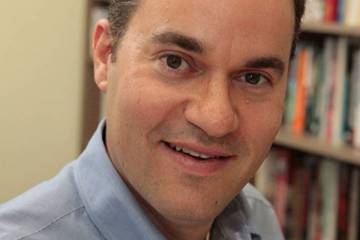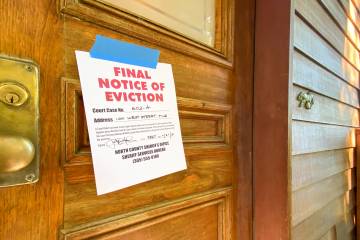When it comes to launching an economic comeback in cities that have suffered decades of decline, Matthew E. Kahn and Mac McComas describe themselves as cautious optimists.
In their new book, Unlocking the Potential of Post-Industrial Cities (Johns Hopkins University Press, 2021), Kahn and McComas explore why six cities—Baltimore, Cleveland, Detroit, Philadelphia, Pittsburgh, and St. Louis—have seen a decline in population and an increase in poverty rates over the last 50 years, and ask how the public and private sectors can work together to craft policies and make investments to revitalize their local economies and create safe, green cities where all young people can reach their full potential.
"The historical obstacles that our six cities must overcome to enjoy economic success are immense but not insurmountable," Kahn and McComas write. "The right set of investments in people and places will unlock the full potential of these post-industrial cities. This book presents a pathway for identifying and implementing such strategies and also provides a set of quantitative benchmarks for judging whether these cities are truly experiencing a comeback."
While much of their work is informed by interdisciplinary collaborations with colleagues, Kahn and McComas approach the subject from the perspective of urban economics, a field of study that uses tools from economics to analyze urban issues including crime, education, housing, and local government. The first chapter of Unlocking the Potential of Post-Industrial Cities is available free online.

Image credit: JHU Press
Kahn is the Bloomberg Distinguished Professor of Economics and Business and holds appointments in the Department of Economics in the Krieger School of Arts and Sciences and in the Carey Business School. He is also the director of the 21st Century Cities Initiative, a research center that brings together faculty and researchers from many schools across Johns Hopkins University around the common interest in how to translate research ideas into improving urban quality of life. McComas is a senior program manager at 21st Century Cities. The Hub reached out to them both for a discussion of the book, its key findings, and what happens when cities invest in human capital and city environment, and not just industry.
What are some of the biggest challenges that the six cities that you focus on currently face that is "locking" their economic potential, and what do you think is at the root of these challenges?
Matthew Kahn: For all six cities, I think it comes down to private sector job creation and building up human capital through skill formation. In the past, all six of our cities were strong manufacturing hubs in their respective niches—Detroit with cars and Pittsburgh with steel, for instance. The question is, when you lose your past golden goose, how do cities pivot?
The decline of manufacturing in the 1970s and 1980s set off a snowball effect. The beauty of manufacturing jobs was that they offered high wages without requiring advanced degrees, so when these manufacturing jobs were lost, there was also a large wage loss. Many young men in particular lost well-paying jobs and pivoted to the service sector, leading to higher rates of poverty; being unemployed raises the risk of substance abuse; women are less likely to marry men if their economic prospects aren't as good; the number of female-headed households increases, as does the number of children growing up in single-parent—and single-income—households. What's more, when a manufacturing factory dies, it doesn't just vanish; the defunct plant remains, tearing down the real estate value in proximity of the plant. So the decline in manufacturing directly increased local poverty, hurting families—especially among Black Americans, who were disproportionally affected—and leaving an environmental legacy of pollution and toxic waste, leading to underinvestment in local real estate.
The 21st Century Cities Initiative collects and analyzes data on why the population in these cities has been declining and how the cities could better grow their existing firms as well as attract new ones. We are cautiously optimistic that by recognizing the challenges that these cities have faced over the last 50 years, there is potential to reinvigorate these cities. In Unlocking the Potential of Post-Industrial Cities, we sketch out how these six cities got to this position and what investments they need to make to pivot and raise the probability that the American Dream remains and becomes attainable for all children.
You make a distinction between urban people and urban places. Why is this an important distinction to make in the context of economic growth?
Mac McComas: Prior to the pandemic, the migration rate in the U.S. was at its lowest level since the 1940s. Simply put, fewer people were moving every year. Poor people in particular have very low migration levels as moving costs are high, they have fewer opportunities, and local social networks are too important to leave behind for an uncertain career move. If poor people are not moving out of poor neighborhoods, it then becomes crucial to invest in those places and improve local quality of life and expand opportunity. At the same time, we need to invest in education and skill building so that everyone can effectively compete for jobs in a modern economy and reach their full potential.
MK: In urban economics, there's an increased appreciation of the point that people have social networks and ties to place. When people don't want to move away from a declining place, we, as a society, face an imperative to help that place to grow.
Another important idea in urban economics is durable housing. In the 1950s, Detroit's economy was booming, and real estate developers built many homes. Over the last 70 years, jobs left Detroit, but the homes remained and started to crumble. When there's a consistent supply of housing, but the demand is shrinking, rents will decline, creating a magnet effect that keeps poor people in a declining place. This makes it even more important to invest in these places.
Your book uses an urban economics approach. How does this approach uniquely lend itself to your analysis?
MK: A central idea in modern urban economics is competition between cities. Cities compete against all other locations in the United States for jobs and people. Baltimore competes with Philadelphia and Washington, D.C.; it also competes with the Baltimore suburbs. I think what urban economists bring to the equation is thinking about incentives and thinking about competition. Why doesn't Baltimore have more private sector jobs? When people graduate from Johns Hopkins, how many choose to remain in Baltimore after they graduate versus moving to New York or San Francisco? Thirty years from now, will more Hopkins graduates choose to remain in Baltimore because the city's economy is stronger? That's the competition. And if a city like Baltimore can keep more Hopkins graduates in Baltimore after graduation, this also creates local service jobs and the whole local economy is stimulated.
MM: Urban economics also brings an experimental approach. Given that our six cities all face budget constraints and need to make meaningful investments in critical services such as early childhood education and public safety, it is crucial to know what policies and programs work and what doesn't work. Urban economists can partner with local governments, businesses, and non-profits to help them craft and rigorously evaluate innovative pilot programs and avoid unintended consequences of well-meaning policy reforms and investments.
If cities are competing against each other, does that mean that one must win while another loses?
MM: Some cities will always do better than others at attracting people and jobs. New York City and San Francisco both declined in population from 1970 to 1980, but those cities were able to reinvent their economies with overwhelming success. Today, there are signs that both of these cities are facing another exodus of people and jobs during the COVID-19 pandemic and the rise of remote work with tech and finance jobs leaving for lower-cost cities. Their loss will be other cities' gain, but New York and San Francisco have proven resilient and able to reinvent themselves.
What is concerning is when a city faces long periods of decline with no comeback. But we believe that these six post-industrial cities are not destined to decline and can show incredible potential if they are able to properly coordinate and target investments in people and places. If more children are able to reach their full potential, everybody wins.
MK: The zero-sum game is an absolutely key question. Every team wants to hire Tom Brady, but there is only one Tom Brady, and he plays for Tampa Bay. If another team hires him, it is that team's gain and Tampa Bay's loss—this is a zero-sum game. We believe, however, that if cities invest in the buildup of local human capital, there is a possibility that this becomes a positive-sum game. If each of these six cities invests in skills investment programs and builds up more talent through the public school systems, community colleges, and on-the-job training, there will be more young people with the skills, personality, and grit for the modern economy, creating a system that feeds on itself.
Many of the challenges you discuss in your book are related, with one often leading to another. Who are the key actors, and where do they intervene?
MK: As a citizen and as a scholar, what interests me in these six cities is the underinvestment problem. There are four dimensions of investment that need to occur: people, places, government, and business. That is, we need to invest in the skills of young people living in these cities, we need real estate developers investing more in the real estate stock of the city and building durable housing, we need better public goods and infrastructure, and we need more private sector job creation.
As an urban and environmental economist, a central theme in my life's work is that cities with great quality of life are more likely to attract people, so that is my starting point: an emphasis on local quality of life through environmental improvement, street safety, cleanliness, clean air, clean water, and taking advantage of the natural beauty of these cities. Each of our cities also has a major university. These anchor institutions can play a central role in fueling a city's comeback, both out of self-interest—to have a high quality of life for students, staff, and faculty to live and work—and as a good community member. Johns Hopkins, for instance, has engaged in initiatives to strengthen Baltimore such as the Hopkins Local hiring and purchasing program.
A key idea that we talk about over and over again is experimentation. As a social scientist, I take a scientific approach to learning about cost effective strategies for improving quality of life. In our book, we talk about many different strategies and initiatives that can be piloted to see not only if they are successful at reducing crime, but also which one has the highest "bang for the buck" in terms of improving street safety per dollar spent. Once we have this data, successful programs can then be scaled up. If our six cities can cost effectively improve their quality of life, then more firms and people will move to and remain in these cities, the increased tax base will bring in more revenue, and the mayor will have a greater capacity to engage in redistribution to help those in greatest need of support.
MM: Everyone—the private sector, local government, people, and neighborhoods—has a role to play if a city is going to make a comeback. One example is Roca, a violence intervention program in Baltimore City that offers young men involved in gang violence the opportunity to transform their lives. For Roca to succeed, this non-profit has to partner with local government public safety agencies to identify individuals at risk. The peer group mentoring offered in this program highlights the importance of social networks and capital in cities. These young men must also live in neighborhoods whose physical attributes impact their everyday life, and as such, need to be invested in. Roca also ultimately relies on the private sector to hire these men after the program provides them with education and skill-building opportunities. These type of collaborative efforts are more likely to succeed as a wider variety of stakeholders are involved and invested in success.
What role does local government play in determining the trajectory of a city?
MM: Local governments serve a key role in providing public goods in the form of parks, transportation, public safety, welfare services, and addressing resident concerns such as dirty streets. Local government also sets the context and rules in which people and businesses exist in cities through policies and legislation such as tax rates, incentives, and laws. Local governments that are transparent, accountable, and foster high levels of civic engagement will be better at retaining and attracting residents. Elected officials can inspire confidence in a city and raise expectations that local quality of life will improve.
MK: Indeed, in many cities, including the six we focus on, the mayor has key powers over how business friendly the city is, as well as over provision of local public goods and taxation. Together, these entities determine the city's quality of life. In Baltimore, for example, Mayor Brandon Scott upgraded the city's open data platform for sharing data with the citizens of Baltimore to increase accountability and transparency of government. There can be greater trust in urban government if people see who is on payroll in Baltimore, what they get paid, if people understand the contracts the government offers, how overtime pay works—in short, what taxpayers are getting for their money. Building up trust in government will go a long way to fueling a city's comeback.
How do you think the COVID-19 pandemic might impact the further development of these cities?
MK: Economists emphasize balanced budget conditions. Post-COVID-19, cities are going to have large budget deficits, and vulnerable people will have even more needs. The ability of city mayors to provide critical services hinges on having a robust local economy. To be generous with redistribution, there has to be a revenue side of the equation to pay for the services, so it is incumbent on the cities to grow their tax base. This comes back to competition: if a city, such as Baltimore, is a great city, it can raise taxes without losing its well-to-do. But if a city is struggling and then raises taxes, its wealthier inhabitants could run off to the suburbs or a different city.
MM: On the other hand, our cities also stand to gain from the many businesses and people who are leaving high-priced cities such as New York, San Francisco, and Boston in search of more affordable cities with the rise of remote work. If cities can signal that they are committed to supporting vibrant entrepreneurial environments and working with businesses to help them grow locally, they will be able to compete well. We've already seen companies such as Facebook announce that they plan to hire in lower cost cities including Philadelphia. Increased investment in pharmaceutical and biotech companies bodes well for Baltimore and Cleveland, who have done a great job of building up innovation economies in those industries. And we're beginning to see this reflected in housing prices and demand. Prices in urban Detroit rose 43%, more than four times the amount of its suburban neighbors, while urban Baltimore saw prices jump 34% compared to just 10% in its surrounding suburbs. What will be key is that these cities can leverage this future increased tax base to invest in community-driven and research-based quality of life improvements in poor neighborhoods that have been overlooked in the past.
So, how do you unlock the economic impact of post-industrial cities?
MM: As we state in our book, there is no silver bullet for economic growth. All cities must invest in education, public infrastructure, real estate, and small business growth if they are to succeed. But what works in one city might not work in another. Baltimore can and should pilot programs that have proven successful in Philadelphia, but these programs need to be rigorously evaluated and leaders need to be open and honest about failure. These cities need to test new and innovative solutions to persistent problems, foster civic engagement, and be open, transparent, and inclusive throughout the process.
MK: We're humble guys—we know that we don't know all the answers. This is why emphasize the importance of experimenting and finding out what works. For each of our cities, it will be crucial to figure out what their edge is, what unique advantages and strengths they have, in competing against other cities, and how to accentuate those. Pittsburgh, for example, is leaning into robotics with Carnegie Mellon University. Baltimore has a lot of natural advantages it could tap into: it has a beautiful waterway, Johns Hopkins University is a world-class institution, and we're only 40 miles from D.C. If a faster and more reliable MARC train could be upgraded to reduce travel time from D.C. to Baltimore, this could offer tremendous possibilities, especially in our new work-from-home economy, effectively making Baltimore a suburb of D.C.
I also want to emphasize again the central role of improving the quality of life. For each of our cities, there needs to be a commitment to reducing crime; a new look at experimenting with strategies to improve public schools so that people with children remain in the city instead of moving to the suburbs; a more business-friendly outlook to attract companies to the city; a welcoming attitude towards immigrants to build up an immigrant population that can breathe new life into cities—these are all planting seeds to grow the cities' new golden goose.
Posted in Voices+Opinion, Politics+Society
Tagged 21st century cities, urban policy











